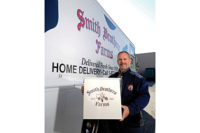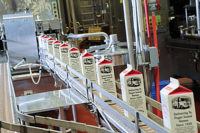It’s not every day you hear a dairy plant likened to an architectural gem. But Bob Whitefield, an engineer at Smith Brothers Farms, likened the milk processing plant in Kent, Wash., to the Taj Mahal. In August 2013, the family-owned milk processor moved from a 90-year-old facility into a newer 50,000-square-foot space that puts production, warehouse and corporate headquarters under the same roof.
The owners of Smith Brothers Farms were considering building a new plant when a former H.J. Heinz soup factory became available. The 30,000-square-foot milk processing facility and 20,000-square-foot warehouse were too good to pass up. Not only is the facility more modern, more efficient and cleaner than the former plant, but also the new space gives the company the room to add capacity when it is needed.
The wide receiving bays, the tall ceilings and the clear spans make the space easy to work in. In the former location, “we were always walking over or under something,” Whitefield said. Employees in many other dairies can relate to that. Processing plants tend to grow over time, with equipment installed in a “best fit” format. Often, piping is barely above head height and conveyors have to be laid out in serpentine configurations.
Complicated, yet easy
Contractor Pro Sales Inc., Puyallup, Wash., was familiar with the project because it built the building. The firm worked as the project manager on the engineering, design and installation. Pro Sales General Manager Alan Sanders said he considered the project complicated and easy. Permitting was complicated because of some county requirements and scheduling was tight because the plant could not be out of commission for too long.
On the other hand, designing and installing the tanks and valves was relatively easy because of the openness of the plant floor and the tall ceilings. It also helped that Pro Sales could use the two boilers and three refrigeration compressors left by the previous tenant. Smith Brothers moved pasteurizing, filling and case packing equipment from the old plant into the new one. The owners installed all new tanks, stainless steel piping and some new case packing machines.
Sanders, who is also the director of engineering, said monthly planning meetings kept the project on track. Near the end, he was meeting almost daily with Smith Brothers. Scott Highland, the president of the dairy processing company, praised Pro Sales for completing the job on time and on budget.
Receiving and processing
Trucks pulling tandem tankers (common in the Pacific Northwest) arrive at the receiving bay. Smith Brothers can turn around a truck in 70 minutes. Production Manager Gary Waldie said it takes 20 minutes to pump milk to one of two 35,000-gallon raw milk silos, 20 minutes for clean-in-place procedures and 30 minutes for visual inspection of the truck plus sampling and testing of the milk in the in-house laboratory.
An HMI panel gives Waldie visuals on the operation of all the plant equipment. (He can troubleshoot the system at home from his laptop, too.) From the panel, Waldie can check all aspects of the plant, as can every employee because they have read-only access to the entire plant. (They have direct access to the areas directly related to their tasks.)
Smith Brothers uses high temperature/short time and vat pasteurizers. The vats give buttermilk and eggnog a better flavor, Waldie said, explaining that the long vat pasteurization time is “the difference between cooking in a crock pot and a microwave.” Waldie and his co-workers say their milk tastes better because it is locally sourced and not treated at the high temperatures of UHT products.
When Smith Brothers and Pro Sales designed the layout, efficiency and safety were paramount. Smith Brothers ordered a mix-proof valve matrix that allows for simultaneous processing and CIP. For instance, the company can process white milk and chocolate milk while it cleans tanks and fillers. In the old plant, these processes had to be done one at a time.
The new plant was designed to be hands-free. Sanders said the valve matrix has eliminated all breaks and Waldie said this has reduced the chance of cross contamination. In the old plant, workers needed to open ports to clean around the gaskets. “Now we just have to do visual inspection,” he said.
Waldie pointed to another example of processing efficiency. In the old plant, Smith Brothers had to make chocolate milk all at once. In the new plant, two shear pumps on the batching tank for chocolate milk allows the processor to mix and hold the milk until it is ready to be pumped to the fillers.
Smith Brothers Farms also cut down on processing waste by adding a tank that reclaims fresh milk from filling operations. Milk is drained into a bowl under the filler and sent back through the pasteurization and bottling process.
The plant is much more automated, with most information being recorded digitally.
“We’ve eliminated most of the paper charts in the plant,” Waldie said. It still keeps the paper disks and hand-written time and temperature notes from the vat pasteurizer and HT/ST unit.
Automation has cut down on labor requirements. One operator can run three fillers, but usually is in charge of two. Smith Brothers fills a variety of formats in paper cartons. The highest volume is in half-gallon containers for home delivery customers and half-pints for school business. On the day of Dairy Foods’visit, Highland was pulling pints off the line to spot-check the weight. The scale is the only piece of equipment he knows how to operate, he joked. But he was serious when he talked about how important it is for him to leave his office and walk the production floor, see the process and talk to employees.
After filling, milk cartons are conveyed to the refrigerated case packing room where automated machinery stacks crates six high. These are assembled into a 54-unit pallet, which is shrink-wrapped by hand and taken to the warehouse. As each pallet is completed, it is entered into the computer system so that accounting can check production. This process of handing off work from one department to another has helped the company keep better track of inventory.
In the warehouse, Smith Brothers’ product is staged in the middle of the floor (in what is called “the cube”) with eggs, yogurt and other home delivery items stored on racks on the perimeter. Pickers go around the cube of milk crates and pick from both sides to build orders. These are then loaded onto each milkman’s truck.
Food safety features
Washington state’s Department of Agriculture inspects the plant regularly. Smith Brothers achieved a 100 rating on the October 2013 Interstate Milk Shippers list. (In 2011, the former plant scored a 90.) Milk cases are stored inside, in the case-washing room in the new plant. (They were stored outdoors at the previous facility.) The dual case-washing machine is completely automatic. After sanitizing, cases move by overhead conveyor to the casing room.
Efficiencies are designed into the CIP room, which holds four wash tanks and four wash fillers. This arrangement cuts cleaning time in half and allows for multitasking in the plant, Waldie said. Smith Brothers rinses the tanks every two weeks to eliminate buildup that affects flavor.
On the environmental front, the new plant should reduce annual water usage by approximately 1.3 million gallons. The processor is adding a system to recapture process water to keep it out of the sewer system. The more efficient warehouse will cut electricity usage by 10% to15%.
Family member Craig Koester, who is the purchasing and facilities manager, has witnessed a lot of changes in the operation of the dairy. An early job at the plant was filling sour cream cups by hand. He recalls workers moving pallets with a dolly. Today forklifts and conveyors move loads around the plant. Computerized record keeping tracks production and inventory.
It’s not unusual for the CEO’s office to be in the best location in a building. That’s not the case here, however. Scott Highland works from a windowless interior office. On the other hand, the employee lunchroom, wrapped by windows, is located in a sunny corner on the first floor. When employees stop in for a break or to eat lunch, they can also print out their pay stubs from a computer station in the room.
For all the modern equipment and better layout, the new factory is about more than just employee comfort and production efficiencies.
“The new factory will help us increase business,” Highland said because it gives the dairy processor more capacity. “Some business will come to us and some we will seek.”
Highland said the family made “a huge investment” in cash and loans in moving from the old plant to the new. The investment is “not to be taken lightly,” he said. The new factory has increased capacity at least 50%, and Highland estimates the company has room to grow and expand another 150%. Raw milk capacity has increased 55% compared to the old plant, and pasteurized milk capacity increased 300%. Smith Brothers already has picked up an organic-milk account and will be processing that milk in early 2014. It seeks other opportunities that might be too small for larger dairy processors but just right for Smith Brothers.
By thinking about its goals and future needs, the Smith Brothers Farms management team built a dairy plant for growth and long-term success.
At-A-Glance
Smith Brothers Farms, Kent, Wash.
Interstate Milk Shippers plant 53-13 (100% enforcement rating, October 2013)
Products made: Milk (conventional and organic), flavored milk, half and half, whipping cream, buttermilk and egg nog in half-pint to 300-gallon formats
Pasteurized tanks: Five, each with a capacity of 8,000 gallons
Blending tanks: One 5,000 gallons; one 8,000 gallons
Vat pasteurizers: Two (for buttermilk and egg nog), each 1,000 gallons
Fillers: Six (one 1/2 gallon; two 1/2-pints; one quart/pint; one gallon; one bag-in-box (also fills 300-gallon totes)
Silo capacity: 78,000 gallons (raw milk); 60,000 gallons (pasteurized milk)










